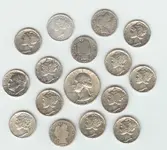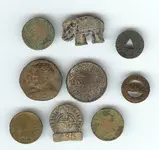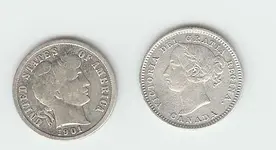Pocket Spill
Bronze Member
- #1
Thread Owner
Just got back from vacation. Did a road trip with my wife to visit some U.S. National Parks out west.
Brought my detector with. When we were in Montana I was able to get in some detecting at some
local city parks in a few towns we stayed in during our trip. Some of the more productive hunting I
have had this year. Got in a total of about 12 hours of detecting and found 16 silver coins!
At 2 of the parks I hunted, the ground was rock hard as this area of Montana is very dry and they do not
get a lot of moisture over the course of the year. As a result a lot of the older targets were only 2 to
5 inches deep. The deepest target I dug at these two locations was only 6 inches deep. At the
third park I hunted it was along a small stream that probably floods in the spring plus they heavily
water this park. Here the older targets were in the typical 6 to 7 inch range and digging was easier.
16 silvers included: 1 1952D Washington; 1 1893 Canadian Dime (flat 3 variety); 3 Barber Dimes
– 1900S, 1901S (Key Date- only 593,000 minted), and 1908; 10 Mercs – 1918, 1919D, 1920D,
1924, 1927, 1939S, 1941, 1942D, and 1943S (2 of them); 1 1952D Rosie.
Other goodies included 3 Indians – no date, 1898, and 1905; an old elephant pin that was in the same
hole as a 1911 Wheatie, a 1924 presidential pin for Progressive Party candidates Robert La Follette and
Burton Wheeler (Wheeler was a Montana senator), a Minneapolis Honeywell pin, a 25 cent trade token,
a circa 1915 Butte, Montana electric railway token, and a circa 1920 Seattle Municipal Railway token.
Not pictured are 30 wheaties I found plus a silver ring.
It was fun hunting but boy was the ground hard at the two older locations I was at. I started cherry
picking high tones. The 1901S was only 2 inches deep. I am really glad I did not scratch it like I did
a couple of the other shallow dimes. I was really surprised a lot of these shallow coins were still there.
I had two people stop and talk to me that were dectorists. One guy uses an Etrac and I could see some
fairly fresh plugs that were actually his in the park I was at. Pictures of the good stuff below including
close-ups of the Canadian dime and the 1901S Barber.




Brought my detector with. When we were in Montana I was able to get in some detecting at some
local city parks in a few towns we stayed in during our trip. Some of the more productive hunting I
have had this year. Got in a total of about 12 hours of detecting and found 16 silver coins!
At 2 of the parks I hunted, the ground was rock hard as this area of Montana is very dry and they do not
get a lot of moisture over the course of the year. As a result a lot of the older targets were only 2 to
5 inches deep. The deepest target I dug at these two locations was only 6 inches deep. At the
third park I hunted it was along a small stream that probably floods in the spring plus they heavily
water this park. Here the older targets were in the typical 6 to 7 inch range and digging was easier.
16 silvers included: 1 1952D Washington; 1 1893 Canadian Dime (flat 3 variety); 3 Barber Dimes
– 1900S, 1901S (Key Date- only 593,000 minted), and 1908; 10 Mercs – 1918, 1919D, 1920D,
1924, 1927, 1939S, 1941, 1942D, and 1943S (2 of them); 1 1952D Rosie.
Other goodies included 3 Indians – no date, 1898, and 1905; an old elephant pin that was in the same
hole as a 1911 Wheatie, a 1924 presidential pin for Progressive Party candidates Robert La Follette and
Burton Wheeler (Wheeler was a Montana senator), a Minneapolis Honeywell pin, a 25 cent trade token,
a circa 1915 Butte, Montana electric railway token, and a circa 1920 Seattle Municipal Railway token.
Not pictured are 30 wheaties I found plus a silver ring.
It was fun hunting but boy was the ground hard at the two older locations I was at. I started cherry
picking high tones. The 1901S was only 2 inches deep. I am really glad I did not scratch it like I did
a couple of the other shallow dimes. I was really surprised a lot of these shallow coins were still there.
I had two people stop and talk to me that were dectorists. One guy uses an Etrac and I could see some
fairly fresh plugs that were actually his in the park I was at. Pictures of the good stuff below including
close-ups of the Canadian dime and the 1901S Barber.








